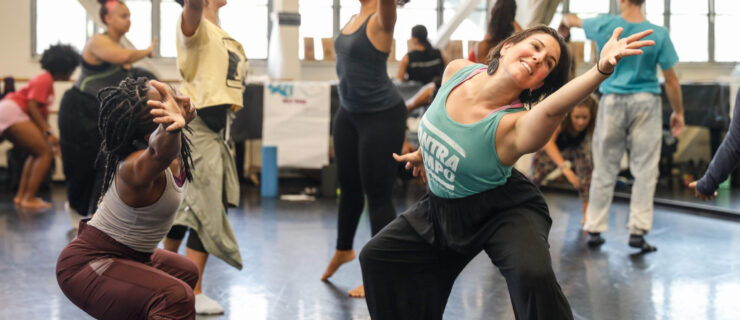Hoofing It
There are no conventional dance steps. There are no conventional production numbers. But in 2008, War Horse’s Toby Sedgwick beat out some of Broadway’s top dance expertise—in the persons of Rob Ashford, Jerry Mitchell, and Casey Nicholaw—to win Britain’s Olivier Award for Best Theatre Choreographer. And Sedgwick, who had never been a dancer or a designer of dances, was so surprised that he walked up to accept his prize without having planned a speech.
Now that the National Theatre production of War Horse has arrived at Lincoln Center’s Vivian Beaumont Theater, Americans can see why Sedgwick trounced the competition. An actor and director trained in mime, a rider from boyhood, Sedgwick is officially in charge of War Horse’s “movement and horse choreography.” He’s responsible for the minutely observed, extraordinarily persuasive maneuvering that turns articulated horse sculptures into living, breathing beasts that trot, walk, and gallop across the stage and straight into the hearts of the audience. Sedgwick thanked the Olivier voters with whinnies, and no one who’d seen the show had any trouble understanding him.
The lifesize horse puppets, created by Basil Jones and Adrian Kohler of the Handspring Puppet Company, are manipulated by teams of three performers. Part actors, part dancers, part puppeteers, two work inside the horse frame to move the front and rear legs, and the third stays alongside the horse to manage the head.
“They’re the hind, heart, and head,” Sedgwick says. “And the amazing thing is if the puppet looks like a horse and is acting like a horse, you don’t see the puppeteers. If there’s a terrible mistake—if the horse is galloping with two legs absolutely parallel, for example—then you see the legs of the puppeteers. It’s something to do with the actual beauty of the puppet itself—you see the puppet and you don’t worry about the people who are in it.”
Enrico Wey worries about the people who are in it, because he is one of them. A dancer and choreographer who has worked with Handspring on other projects, he has four job descriptions in War Horse. Twice a week he puts on a harness and manipulates the rear end of Joey, the spirited country horse taken from the boy who raised him to help the British fight World War I. Twice a week Wey moves over to play the rear end of Topthorn, the aristocratic cavalry steed Joey follows into battle. In the other four performances, he gets to “rest,” playing an assortment of people—villagers and soldiers—and things—birds, barbed wire, a tank.
The break is necessary because being one-third of a horse is exhausting. The horse frame itself is not heavy; creating the illusion of weight is one of the things Sedgwick works on with the teams. But add a rider—the horses are ridden repeatedly during the show—and carry both the horse frame and the rider at a gallop or trot, and you’re talking serious work. The horses also rear up and jostle one another in very close quarters, so, like dancers, the performers risk injury if they lose concentration. The confrontation between Joey and Topthorn is so dangerous it’s rehearsed eight times a week, before every performance.
“People have to be quite physically adept,” Sedgwick says. Also strong. Sedgwick recalls that before the puppets had been designed, he and Kohler “put two people with a ladder between them, and then someone jumped up and sat astride the ladder. The two who were standing said, ‘Yeah, I can take that.’ ”
Finding strong, physical actors or dancers isn’t hard. What is hard, Sedgwick says, is finding actors or dancers with those skills who are also willing—and able—to become invisible. That’s why puppet experience is considered so essential. Puppetry requires people to channel their performance energy away from their own bodies and into an object. “It can be taught,” Sedgwick says, “but we don’t have time to do that.”
Wey acquired it at Handspring. “One of the things you learn is that a puppet has a constant struggle to be alive,” he says. “When you’re performing as a dancer, no one questions the fact that you’re alive.” While War Horse doesn’t exploit his dance background per se, Wey sees it as an important asset. “As a dancer you’re very aware of how you’re carrying yourself onstage. So if I’m ready to move, that informs the audience that the horse is also in that stance. If the horse is ready to run away, I’m carrying that tension in my body positioning.”
Wey also notes that dance has given him the tools for working in a team. “A lot of my work is with improvisation and ensemble thinking,” he says. “That’s part of the reason I was so drawn to this.” And teamwork, Sedgwick says, is key. “They all have to think as one. When one of them makes a move, the other two have to go with it,” he says.
Wey says he has learned to understand his teammates’ physicality, how their bodies prepare. “A lot of it,” he says, “is about taking on or receiving cues as quickly as possible, so that if someone offers an impulse we can immediately snap to it. It’s just getting to know your team.” And, of course, remembering when to whinny.
Sylviane Gold writes on theater for
The New York Times.
Sedgwick’s movement brings Topthorn and Joey to life. Photo by Paul Kolnik, Courtesy Lincoln Center Theater.




